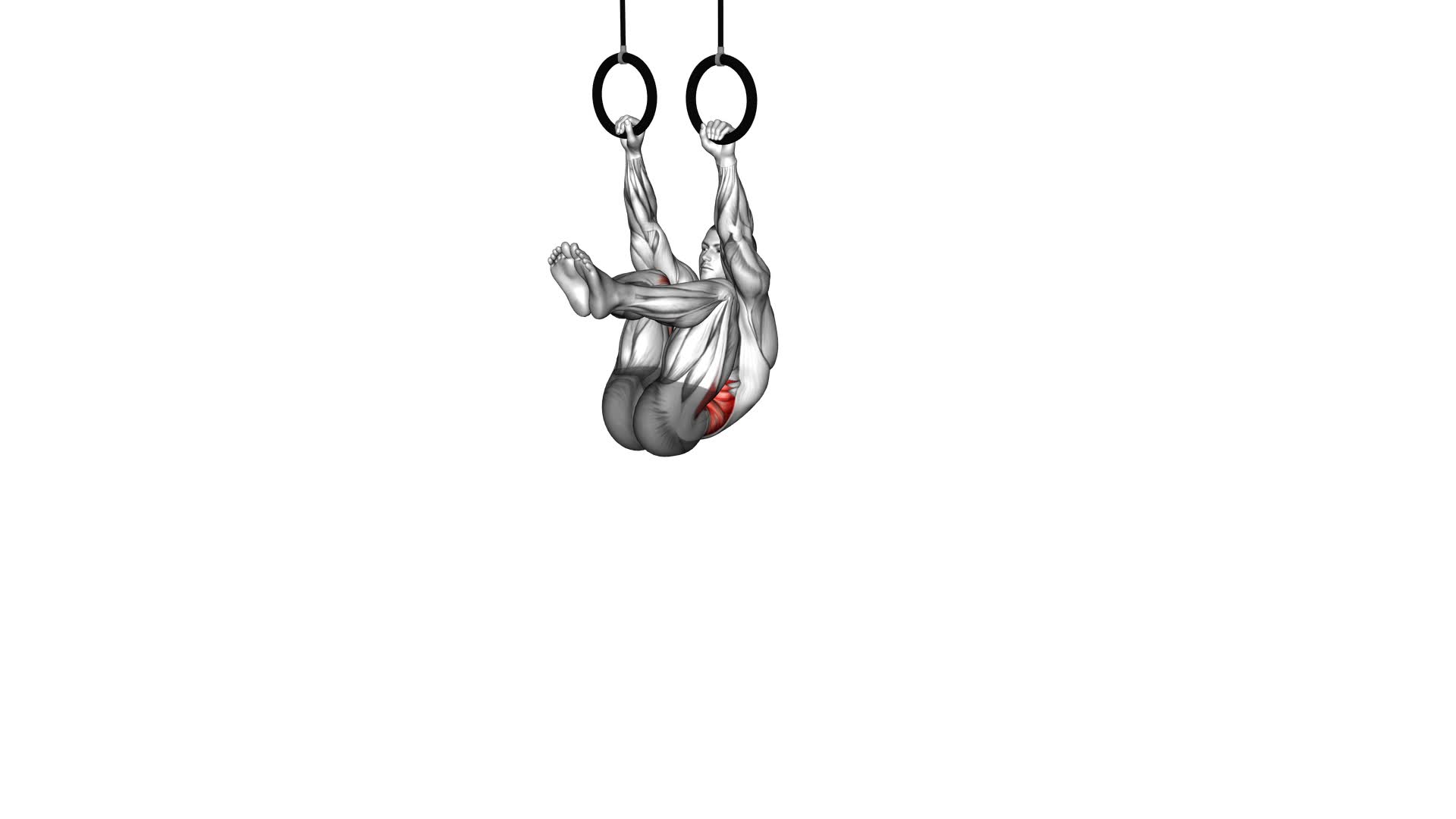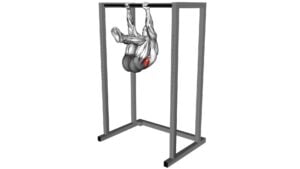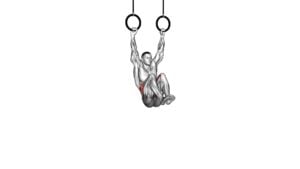Ring Hanging Knees to Elbows – Video Exercise Guide & Tips

Are you looking for a challenging and effective exercise to strengthen your core? Look no further than Ring Hanging Knees to Elbows!
Watch This Exercise Video
This video exercise guide will show you the proper form and technique, as well as provide helpful tips to maximize your workout.
Whether you're a beginner or more advanced, this exercise can be modified to suit your fitness level.
Get ready to feel the burn and take your core strength to the next level.
Let's dive in!
Key Takeaways
- Ring Hanging Knees to Elbows is a highly effective exercise for developing core strength and engaging the upper body.
- This exercise targets the abdominal muscles, obliques, lower back, arms, shoulders, and chest.
- Proper form and technique are crucial, including keeping the shoulders down and back, avoiding swinging or excessive momentum, and using the abdominal muscles to initiate the movement.
- Modifications and progressions can be made to increase the difficulty and target specific muscle groups, and workout intensity can be maximized by incorporating HIIT and compound exercises.
Benefits of Ring Hanging Knees to Elbows
You will experience significant core strength gains when performing Ring Hanging Knees to Elbows. This exercise is highly effective for engaging your upper body and developing a strong core. By hanging from the rings and bringing your knees up to touch your elbows, you activate your abdominal muscles, obliques, and lower back. The constant engagement of these muscles helps to improve stability and balance throughout your entire body.
Ring Hanging Knees to Elbows also targets your upper body, specifically your arms, shoulders, and chest. As you lift your knees towards your elbows, you're required to use your upper body strength to stabilize and control the movement. This not only builds strength in these areas but also improves your overall upper body muscular endurance.
Additionally, this exercise challenges your grip strength, as you need to maintain a firm grip on the rings throughout the movement. By consistently practicing Ring Hanging Knees to Elbows, you can expect to see improvements in your grip strength over time.
Equipment and Set-Up for the Exercise
To properly perform Ring Hanging Knees to Elbows, it's essential to have the necessary equipment and set-up in place. Here's what you need and how to set it up:
- Ring attachments: You'll need a pair of gymnastic rings that can be easily adjusted to your desired height. Make sure they're securely attached to a sturdy overhead structure, such as a pull-up bar or ceiling beam.
- Proper grip technique: Before starting the exercise, ensure that you have a firm and secure grip on the rings. Your palms should be facing down, and your fingers should be wrapped around the rings. Maintain a tight grip throughout the movement to prevent slipping or losing control.
- Ring height: Adjust the rings to a height where you can comfortably hang with your feet off the ground and your arms fully extended. This will allow for a full range of motion during the exercise.
- Spacing: Ensure that the rings are spaced shoulder-width apart. This will provide a stable base and allow you to maintain proper form while performing the exercise.
Proper Form and Technique
After setting up the necessary equipment and ensuring a secure grip, maintain proper form and technique while performing Ring Hanging Knees to Elbows. This exercise targets the core and upper body, specifically the abs, hip flexors, and arms. To execute it correctly, start by hanging from the rings with your arms fully extended. Engage your core and lift your knees towards your chest, aiming to touch your elbows with your knees.
Here are some tips to ensure proper form and technique:
- Keep your shoulders down and back to maintain stability and prevent shrugging.
- Maintain a controlled and smooth motion throughout the exercise, avoiding any swinging or excessive momentum.
- Focus on using your abdominal muscles to initiate the movement, rather than relying solely on your hip flexors.
- Exhale as you bring your knees up and inhale as you lower them back down.
- Keep your elbows slightly bent to minimize stress on the joints.
- Avoid using excessive momentum or swinging your body, as this can compromise the effectiveness of the exercise and increase the risk of injury.
Common errors to watch out for include using momentum to swing your body, not fully engaging the core muscles, and allowing the shoulders to shrug or hunch.
To modify the exercise, you can perform hanging knee raises instead, where you focus on lifting your knees as high as possible without touching your elbows. This variation is beneficial for beginners or those with limited core strength. Remember to always listen to your body and adjust the exercise as needed to ensure proper form and technique.
Common Mistakes to Avoid
Maintaining proper form and technique is crucial to avoid common mistakes while performing Ring Hanging Knees to Elbows. To ensure you get the most out of this exercise and minimize the risk of injury, here are some common mistakes to avoid:
- Using momentum: One of the most common mistakes is relying on momentum to swing your legs up. This not only reduces the effectiveness of the exercise but also puts strain on your shoulders and back. Instead, focus on controlled movements and engage your core muscles.
- Failing to engage the core: To properly execute Ring Hanging Knees to Elbows, it's important to engage your core muscles throughout the movement. Neglecting to do so can lead to a lack of stability and compromised form.
- Not maintaining shoulder stability: Another common mistake is allowing your shoulders to shrug or roll forward during the exercise. This can lead to shoulder impingement and discomfort. Keep your shoulders down and back, maintaining stability throughout the movement.
- Not using the full range of motion: It's important to fully extend your legs and bring your knees up to touch your elbows. Failing to do so limits the effectiveness of the exercise and prevents you from fully engaging your abdominal muscles.
Modifications and Progressions
To modify and progress the Ring Hanging Knees to Elbows exercise, you can challenge yourself by increasing the difficulty or adding variations to target specific muscle groups. If you find the exercise too challenging, you can start by performing knee raises instead of trying to touch your knees to your elbows. This will help you build the necessary strength and coordination before attempting the full movement.
To increase the difficulty, you can try performing the exercise with straight legs instead of bent knees. This will engage your core and hip flexors to a greater extent. Another alternative is to perform the exercise using one arm at a time, which will require more stability and control.
If you want to target specific muscle groups, you can incorporate variations into your routine. For example, you can perform side-to-side knee raises to target your obliques. To engage your lower abs, you can try performing hanging leg raises with your legs straight in front of you.
Remember to always maintain proper form and engage your core throughout the exercise. Start with modifications that match your current fitness level, and gradually progress as you get stronger. By incorporating alternatives and variations, you can continue challenging yourself and achieving your fitness goals.
Tips for Maximizing Your Workout
Maximize the effectiveness of your workout with these key tips:
- Increase workout intensity: To get the most out of your workout, push yourself to work harder. This can be achieved by increasing the weight, reps, or intensity of your exercises. By challenging your body, you'll stimulate muscle growth and improve overall fitness.
- Incorporate high-intensity interval training (HIIT): HIIT workouts involve short bursts of intense exercise followed by brief periods of rest. This type of training has been shown to burn more calories and improve cardiovascular fitness in a shorter amount of time. By incorporating HIIT into your routine, you can maximize your workout in less time.
- Focus on compound exercises: Compound exercises, such as squats, deadlifts, and push-ups, work multiple muscle groups at once. This not only saves time but also increases the overall effectiveness of your workout. By engaging more muscles, you'll burn more calories and improve strength more efficiently.
- Prioritize time management: To maximize your workout, it's important to plan your time effectively. Set specific goals, create a structured schedule, and eliminate distractions. By managing your time efficiently, you'll be able to dedicate more focus and energy to your workout, ensuring you get the most out of each session.
Frequently Asked Questions
How Many Calories Does Ring Hanging Knees to Elbows Burn?
When you perform ring hanging knees to elbows, you engage multiple muscles in your core and upper body, resulting in a high calorie burn. This exercise specifically targets your abs, obliques, and hip flexors, activating them to generate movement.
The more intense and controlled your movements are, the more calories you can expect to burn.
Incorporating this exercise into your routine can help you achieve your calorie burning and muscle activation goals.
Can Ring Hanging Knees to Elbows Help Improve Flexibility?
Ring hanging knees to elbows is a challenging exercise that can help improve your flexibility. By engaging your core and stabilizing your shoulders, this exercise targets multiple muscle groups and promotes increased range of motion.
As you hang from the rings and bring your knees to your elbows, you'll be stretching and strengthening your abs, hip flexors, and upper back. This movement can also enhance overall core strength and increase shoulder stability, leading to improved flexibility over time.
Is It Necessary to Have Strong Upper Body Strength to Perform This Exercise?
Having strong upper body strength is crucial for performing the ring hanging knees to elbows exercise effectively. It helps you maintain control and stability while hanging on the rings.
Grip strength is also important, as it allows you to hold onto the rings securely.
For beginners, modifications can be made by starting with bent knees and gradually working towards straightening them.
This exercise is a great way to improve your overall upper body strength and core stability.
Will Ring Hanging Knees to Elbows Help in Building Six-Pack Abs?
Ring hanging knees to elbows is a great exercise for building core strength and can definitely help in developing six-pack abs. By hanging from the rings and bringing your knees up to your elbows, you engage your abdominal muscles, including the rectus abdominis. This exercise also targets the hip flexors and obliques.
If you're looking for variations of knees to elbows exercises, you can try hanging knee raises, toes to bar, or dragon flags. These exercises will challenge your core and help you achieve those six-pack abs.
How Long Should One Hold the Position During Ring Hanging Knees to Elbows Exercise?
To effectively progress in the ring hanging knees to elbows exercise, it's important to focus on the duration of the hold.
Without the context of the exercise guide, the ideal length of time to hold the position can vary.
However, common mistakes to avoid include rushing through the movement and sacrificing proper form.
Conclusion
In conclusion, ring hanging knees to elbows is an effective exercise that targets the core muscles while also improving grip strength and stability.
By following proper form and technique, avoiding common mistakes, and incorporating modifications and progressions, you can maximize the benefits of this exercise.
Remember to always prioritize safety and consult with a fitness professional if you have any concerns or questions.
Keep pushing yourself and enjoy the results of your hard work!

Author
Years ago, the spark of my life’s passion ignited in my mind the moment I stepped into the local gym for the first time. The inaugural bead of perspiration, the initial endeavor, the very first surge of endorphins, and a sense of pride that washed over me post-workout marked the beginning of my deep-seated interest in strength sports, fitness, and sports nutrition. This very curiosity blossomed rapidly into a profound fascination, propelling me to earn a Master’s degree in Physical Education from the Academy of Physical Education in Krakow, followed by a Sports Manager diploma from the Jagiellonian University. My journey of growth led me to gain more specialized qualifications, such as being a certified personal trainer with a focus on sports dietetics, a lifeguard, and an instructor for wellness and corrective gymnastics. Theoretical knowledge paired seamlessly with practical experience, reinforcing my belief that the transformation of individuals under my guidance was also a reflection of my personal growth. This belief holds true even today. Each day, I strive to push the boundaries and explore new realms. These realms gently elevate me to greater heights. The unique combination of passion for my field and the continuous quest for growth fuels my drive to break new ground.







